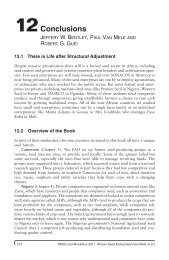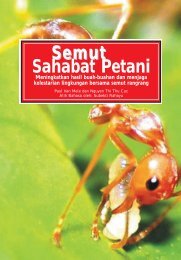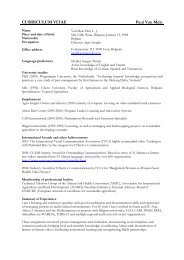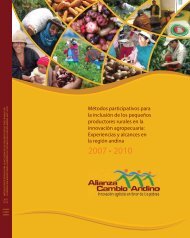Video-mediated farmer-to-farmer learning for sustainable agriculture
Video-mediated farmer-to-farmer learning for sustainable agriculture
Video-mediated farmer-to-farmer learning for sustainable agriculture
Create successful ePaper yourself
Turn your PDF publications into a flip-book with our unique Google optimized e-Paper software.
From an innovation system perspective, having videos that serve or are used by many (known and<br />
unknown) service providers is a great achievement. It also means there is a need <strong>to</strong> “let go” and<br />
that moni<strong>to</strong>ring of the spontaneous dissemination and use of video discs at a global scale will<br />
always be an approximation that depends on people’s willingness <strong>to</strong> provide feedback as they have<br />
neither ties nor accountability <strong>to</strong> the project trying <strong>to</strong> moni<strong>to</strong>r the video use.<br />
Moni<strong>to</strong>ring video use is possible, as shown by Digital Green and AfricaRice, but keeping track of<br />
videos that reach <strong>farmer</strong>s in off-line modus implies huge moni<strong>to</strong>ring challenges.<br />
“It is very difficult, as you can imagine, moni<strong>to</strong>ring the use of the videos by other<br />
organizations. Currently, I am aware of the following organizations (outside of STCP and<br />
partners) who use them: Technoserve Tanzania (translated in<strong>to</strong> Swahili); Armajaro Ltd (a<br />
cocoa buying company <strong>for</strong> use in Nigeria and Ghana) and ECHOES/Winrock International<br />
(a private sec<strong>to</strong>r funded project in Ghana)”<br />
Sonii David, IITA, Ghana<br />
Future ef<strong>for</strong>ts <strong>to</strong> stimulate a global exchange of <strong>farmer</strong> training videos may include a mix of the<br />
above-mentioned types of videos, and elements of the various models, keeping in mind all the pros<br />
and cons. Be<strong>for</strong>e presenting some scenarios as <strong>to</strong> how a web-based exchange plat<strong>for</strong>m might take<br />
shape (Section 7), let us take a closer look at the range of agricultural training videos available on<br />
the internet and explore who should be the target of such a plat<strong>for</strong>m.<br />
5 Agricultural videos on the internet<br />
Literature, surveys conducted by AfricaRice on gender and media in nine African countries, and<br />
results from the on-line survey suggests that very few <strong>farmer</strong>s in developing countries use the<br />
internet, whereas extension service providers do access the internet in search <strong>for</strong> quality training<br />
materials, in<strong>for</strong>mation and networking. Knowing who uses which ICT technologies is crucial as the<br />
intention and capacities of the people deploying them are key <strong>to</strong> the success of any<br />
ICT4Development intervention, as illustrated by the following quote.<br />
“As we conducted research projects in multiple domains (education, microfinance,<br />
<strong>agriculture</strong>, health care) and with various technologies (PCs, mobile phones, cus<strong>to</strong>mdesigned<br />
electronics), a pattern, having little <strong>to</strong> do with the technologies themselves,<br />
emerged. In every one of our projects, a technology’s effects were wholly dependent on<br />
the intention and capacity of the people handling it.”<br />
Kentaro Toyama, University of Cali<strong>for</strong>nia (2010)<br />
5.1 Internet use by <strong>farmer</strong>s<br />
In Ghana, only nine of the 200 rice <strong>farmer</strong>s interviewed had used the internet be<strong>for</strong>e, four had used<br />
it on their own, while five had used it with assistance. They used it <strong>for</strong> social networking, marketing<br />
their produce and accessing news. Only one <strong>farmer</strong> used the internet <strong>to</strong> obtain in<strong>for</strong>mation on rice<br />
(Parker Halm, 2010).<br />
Various national and international organizations have funded telecentres in Africa. In Tanzania,<br />
<strong>farmer</strong>s do not use and benefit from the potential that is offered by telecentres in terms of<br />
in<strong>for</strong>mation access. Most users are students, and civil servants working at district headquarters.<br />
<strong>Video</strong> <strong>for</strong> <strong>farmer</strong>s Agro-Insight, Oc<strong>to</strong>ber 2011 page 28







